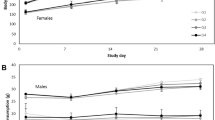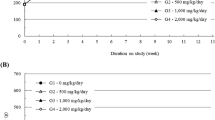Abstract
Extracts of Hordeum vulgare and Chrysanthemum zawadskii, two traditional herbal medicines, have long been used to treat women's diseases. Our previous studies have confirmed that these extracts could help relieve the symptoms of premenstrual syndrome by inhibiting prolactin release. A mixture of these natural products was named Lomens-P0. In this study, we conducted three genotoxicity tests (bacterial reverse mutation, mammalian chromosome aberration, and mammalian erythrocyte micronucleus studies) and four oral toxicity tests (single-dose, 2-week repeated-dose, and 13-week repeated-dose studies in rodents, and a single-dose dose-escalation toxicity study in a non-rodent model) to confirm the potential toxicity and safety of Lomens-P0. The results of this series of tests indicated Lomens-P0 did not induce genotoxicity, and the NOAEL for the rodent was 2000 mg/kg BW/day. Similarly, no toxic effects were evident in the single-dose-escalation study in the non-rodent model. In conclusion, we confirmed that Lomens-P0 might have potential utility as a raw material for nutraceuticals and natural medicines.


Similar content being viewed by others
References
Shi QW, Li LG, Huo CH, Zhang ML, Wang YF (2010) Study on natural medicinal chemistry and new drug development. Chin Tradit Herb Drugs 41:1583–1589
Butler MS (2008) Natural products to drugs: Natural product-derived compounds in clinical trials. Nat Prod Rep 25:475–516. https://doi.org/10.1039/b514294f
Ge YB, Cheng XZ, Yan AL, Xu J (2015) Research progress of anti-tumor mechanism of paeoniflorin. J Chin Med Mater 38:636–639
Zhao PW, Niu JZ, Lee DY, Wang JF, Sun YL, Li YD (2012) Effect and mechanism of traditional Chinese medicine and their active constituents in postmenopausal osteoporosis. Chin J Chin Mater Med 37:1693–1698
Jiang HB, Wang J, Su JH, Fang MM, Yang N, Yang JW, Wang F, Xiao H, Tang JR (2015) Effect of tetrahydropalmatine on expression of Cav1.2 dorsal root ganglion neurons in mice with sciatic nerve chronic constriction injury. Chin Pharm Bull 31:1598–1603
Zhao SX, Ye WC, Gu JH, Liu JH, Zhang XQ, Yin ZQ, Wang H, Zhang LH, Guo YZ, Feng JX (2012) Medicinal plant resources in Lingnan area and emergency medicine in Ge Hong zhou hou bei ji fang. Asia Pac Tradit Med 8:11–12
World Health Organization, Regional Office for South-East Asia (2010). Traditional herbal remedies for primary health care. https://apps.who.int/iris/handle/10665/206024. Accessed 1 Nov 2020
Zeng Y, Pu X, Yang J, Du J, Yang X, Li X, Li L, Zhou Y, Yang T (2018) Preventive and therapeutic role of functional ingredients of barley grass for chronic diseases in human beings. Oxid Med Cell Longev 2018:3232080. https://doi.org/10.1155/2018/3232080
Tosh SM (2013) Review of human studies investigating the postprandial blood-glucose lowering ability of oat and barley food products. Eur J Clin Nutr 67:310. https://doi.org/10.1038/ejcn.2013.25
Aune D, Chan DSM, Lau R, Vieira R, Greenwood DC, Kampman E, Norat T (2011) Dietary fibre, whole grains, and risk of colorectal cancer: Systematic review and dose-response meta-analysis of prospective studies. BMJ 343:d6617. https://doi.org/10.1136/bmj.d6617
Ames NP, Rhymer CR (2008) Issues surrounding health claims for barley. J Nutr 138:1237S-1243S. https://doi.org/10.1093/jn/138.6.1237S
Wnag X, Ma L, Zhang EJ, Zou JL, Guo H, Peng SW, Wu JH (2014) Water extract of fructus hordei germinatus shows antihyperprolactinemia activity via dopamine D2 receptor. Evid Based Complementary Altern Med 2014:579054. https://doi.org/10.1155/2014/479054
Li MX, Liu H, Li Y, Wnag F, Zhang PR, Zang P (2015) Anti-hyperprolactinemic effect of formula malt decoction, a Chinese herbal cocktail. Trop J Pharm Res 14:263–269. https://doi.org/10.4314/tjpr.v14i2.11
Burt S (2004) Essential oils: their antibacterial properties and potential applications in foods–a review. Int J Food Microbiol 94:223–253. https://doi.org/10.1016/j.ijfoodmicro.2004.03.022
Ministry of Food and Drug Safety. (2015) Regulation on Pharmacology Study for Pharmaceuticals. MFDS Notification No. 2015–83.
Lennartsson AK, Jonsdottir IH (2011) Prolactin in response to acute psychosocial stress in healthy men and women. Psychoneuroendocrinology 36:1530–1539. https://doi.org/10.1016/j.psyneuen.2011.04.007
Pałubska S, Adamiak-Godlewska A, Winkler I, Romanek-Piva K, Rechberger T, Gogacz M (2017) Hyperprolactinemia—a problem in patients from the reproductive period to the menopause. Przegla̜d Menopauzalny 16:1–7. https://doi.org/10.5114/pm.2017.67364
Majumdar A, Mangal NS (2013) Hyperprolactinemia. J Hum. Reprod Sci 6:168–175. https://doi.org/10.1403/0974-1208.121400
Seidlova-Wuttke D, Wuttke W (2017) The premenstrual syndrome, premenstrual mastodynia, fibrocystic mastopathy and infertility have often common roots: effects of extracts of chasteberry (Vitex agnus castus) as a solution. Clin Phytoscience 3:6. https://doi.org/10.1186/s40816-016-0038-z
Braverman PK (2007) Premenstrual syndrome and premenstrual dysphoric disorder. J Pediatr Adolesc Gynecol 20:3–12. https://doi.org/10.1016/j.jpag.2006.10.007
Halbreich U, Borenstein J, Pearlstein T, Kahn LS (2003) The prevalence, impairment, impact, and burden of premenstrual dysphoric disorder (PMS/PMDD). Psychoneuroendocrinology 28:1–23. https://doi.org/10.1016/S0306-4530(03)00098-2
Acknowledgements
This work was supported by the Korean Institute of Planning and Evaluation for Technology in Food, Agriculture, and Forestry (IPET) through the High Value-added Food Technology Development Program, funded by the Ministry of Agriculture, Food and Rural Affairs (MAFRA) (317041-5).
Author information
Authors and Affiliations
Corresponding author
Ethics declarations
Conflict of interest
The authors declared no potential conflict of interest with respect to the research, authorship, and/or publication of this article.
Supplementary Information
Below is the link to the electronic supplementary material.
Rights and permissions
About this article
Cite this article
Jeong, Y.J., Jeon, H., Kim, E.J. et al. Evaluation of the acute, sub-chronic and chronic oral toxicity, genetic toxicity, and safety of a Lomens-P0. Toxicol Res. 38, 69–90 (2022). https://doi.org/10.1007/s43188-021-00090-5
Received:
Revised:
Accepted:
Published:
Issue Date:
DOI: https://doi.org/10.1007/s43188-021-00090-5




